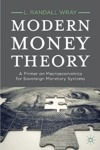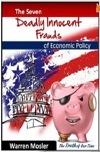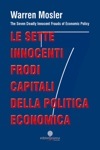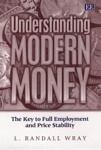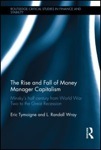Warren, thanks for being connected with us this evening. I know you are in Connecticut now. We are in Switzerland, so I think a more general point of view of the world is probably more of interest to all of us although I understand that you might be more current on how to fix the U.S., as that is where you hope to have an impact soon.
*In the United States, my prescription includes 1) what we call a payroll tax holiday, i.e., a tax reduction, 2) a revenue distribution to the states by the federal government and 3) a federally funded $8.00-per-hour job for anyone willing and able to work. *
*For the euro zone, I propose a distribution from the European Central Bank to the national governments of perhaps as much as 20 percent of GDP to be done on a per capita basis so it will be fair to all the member nations*.
*AT*: Are you saying that the effect of such annual distribution would be like the effect of the discovery of a new gold mine every year in a country under the gold standard?
*WM*: Well, no, it’s different, because on a gold standard what we call the money supply is constrained in any case, whereas when you get to a currency it’s the opposite: the currency itself is never constrained. So you have a whole different dynamic.
Let me just expose my point from a slightly different point of view. The reason the EU can’t simply guarantee all the nations, and the ECB can’t simply guarantee all the national governments is because if they did, whoever “deficit spends” the most, wins. You would get a race to the bottom of extreme moral hazard that quickly winds up in impossible inflation. So *therehas to be some kind of mechanism to control government deficit spending for the member nations*. They did it through the SGP, that sets the 3 percent limit, and there’s no way around that dilemma. It can’t be done through market forces. It has to be done through the SGP. What they did is to leave the national government on a stand-alone basis, so there would be market discipline, but we’ve seen that that does not work either. They’ve got to get back to a situation where they are not subject to the mercy of market forces but at the same time they don’t want the moral hazard of some unlimited fiscal expansion where anybody can run a 5, 10, 20 percent deficit with inflationary effects.
*My proposal eliminates the credit risk at the national government level, so they are no longer restrained by the markets in their ability to borrow, but it makes them dependent on annual distributions from the ECB in order to maintain this freedom to fund themselves*.
And because they are dependent on the ECB’s annual check, the ECB has a policy to then be able to remove that check to impose discipline on these countries. *By having this policy tool to withhold payments, rather than implement fines, the EU would be in a much stronger position to enforce the deficit limits they need to prevent the race to the bottom of nations*.
*AT*: Your proposed ECB distribution would have the immediate effect of reducing the interest rate spread between German and Greek bonds. However, if the 3-percent deficit constraint remains in place, there is not much hope of prosperity in Europe. Do you agree?
*WM*: Right. The demand management would be based on the SGP: if they decide a 3-percent deficit is not adequate for the level of aggregate demand they may go up to 4, 5, or 6 percent or whatever level they choose. It’s always a political decision for them, and it’s always going to be a political decision. If they choose something too low, then they’re going to have higher unemployment. If they choose something too high, they’re going to have inflation. And so it’s going to be a political choice, no matter how you look at. But the thing is, how do you enforce the political choice? Right now they can’t enforce it. Right now, they’ve been enforcing it through the fining of member nations. But it doesn’t work. So they’ve lost their enforcement tool.
The other problem they have is this: because of the credit sensitivity of the national governments, when countercyclical deficits go up like now, which are needed to restore aggregate demand, output and employment, what happens is that the deficits challenge the creditworthiness of the national governments. *This is an impossible situation with national governments risking default because of the insolvency risk. They are in a completely impossible position to accomplish any of their goals. *
Whereas, reversing the situation, i.e., going from “fines as discipline” to “withholding payments as discipline” puts them in a position that is manageable. It still then requires wise management for the correct level of deficits, for the correct level of aggregate demand, but at least it’s possible. Right now, it’s unstable equilibrium, and what I am proposing switches it to a stable equilibrium, as they used to say in engineering class.
*AF*: If I understand correctly, the essence of the policies that you are suggesting, both in the U.S. and in Europe, involve a certain level of deficit spending and debt accumulation. Then one could expect the dollar/euro exchange rate not to move much because people would probably tend to dislike both currencies the same way. How would you see the interaction of these two areas with emerging markets that are in a totally different economic environment and cycle, and whose currencies are actually currently on the rise?
*WM*: Right, if you look at nations like India and even Brazil, they all have high interest rates and high deficits that help them get through. China, as well, maintains an extremely high deficit offsetting its internal savings desires. China may have overdone it, and it has to face an inflation problem, but this is a different story. *I think that the U.S. is in a far better situation than the euro zone right now, because our budget deficits do not represent the sustainability issues or credit issues*.
The EU has put its member nations in the same position as the U.S. states, as if Germany, or Greece, were like Connecticut, or California. They put all their member nations in the same position as state governments but without the federal government spending that the U.S. uses to help them out. This puts the whole burden of sustaining aggregate demand on European member nations. To get an analogy in the U.S., *if the U.S. had to run a trillion and a half million dollar deficit last year at the federal level, and if the only way that could have happened was at the state level, the U.S. would have been in much the same position as the EU, with all our states right on the edge of default.* So because we have our deficit at the federal level, instead of state level, we are in a much stronger position than the EU right now.
You may have already reviewed the mechanics of how nations like the U.S. or the U.K. do their public spending in the conference, but let me do it very quickly. When the United States spends money that it doesn’t tax, it credits the reserve account of whoever gets that money. Now, a reserve account at the central bank is nothing more than a checking account.
Let me now use the example of China so I can combine the problem of external debt with deficit spending at the same time. China gets its dollars by selling goods and services in the United States. When China gets paid, the dollars go into its checking account at the Federal Reserve Bank, and when China buys Treasury securities, all that happens is that the Federal Reserve transfers the funds from their checking account at the Federal Reserve to their securities accounts at the Federal Reserve. U.S. Treasury securities are accounted much like savings accounts at a normal commercial bank. When they do that, it’s called “increasing the national debt”, although when it’s in their checking account it doesn’t count as national debt. The whole point is that the spending of dollars by the federal government is nothing more than the Federal Reserve Bank changing numbers off in someone’s reserve account. The person doing this at the Treasury doesn’t care if funds are in the reserve account at the central bank; it makes no difference at all, operationally. *There is no operational connection between spending, taxing, and debt management.* Operationally, they are completely distinct. And the way any government like the United States or the U.K. or Japan pays off its debt is the same: just transfer funds from someone’s security accounts back to the reserve accounts at your own central bank, that’s it. And this happens every week with hundreds of billions of dollars. None of this acts as an operational constraint on government spending. There is no solvency issue. There is no default condition in the central banks’ computer.
Now, when you get to the EU, it all changes because all this has been moved down to the national government level, and it’s not at some kind of federal level the way it is in the United States. There is no default risk for the U.S., for the U.K., or for Japan where the debt is triple that of the U.S. and double that of Greece. It is all just a matter of transferring funds from one account to another in your own central bank.
*AT*: I’m glad you touched upon the question of China accumulating credits with the U.S., because this is poorly understood. Money that Chinese earn by sending merchandise to the United States are credits in the U.S., and these credit units are nonredeemable, so Chinese owners can do nothing with these things unless they use them to buy American products, and if they do, those units become profits for American firms. But there is also another possibility, which sometimes raises concerns in the larger public, and this is what happens if China should choose to get rid of these dollars by selling the U.S. securities they own. While the amount of dollars owned by foreigners doesn’t change, the price of the dollar would in fact decline. If China sells off American debt, dollar depreciation may be substantial.
*WM*: Operationally, it’s not a problem because if they bought Euros from the Deutsche Bank, we would move their dollars from their account at the Fed to the Deutsche Bank account at the Fed. The problem might be that the value of the dollar would go down. Well, one thing you’ve got to take note of is that the U.S. administration is trying to get China to revaluate currency upward, and this is no different from selling off dollars, right? So, what you are talking about (selling off dollars) is something the U.S. is trying to force to happen, would you agree with that?
*AT*: Yes!
*WM*: Okay, so we’re saying that we’re trying to force this disastrous scenario—that we must avoid at all costs—to happen. This is a very confused policy. *What would actually happen if China were to sell off dollars? Well, first of all, the real wealth of the U.S. would not change: the real wealth of any country is everything you can produce domestically at full employment plus whatever the rest of the world sends you minus what you have to send them, which we call real terms of trade.* This is something that used to be important in economics and has really gone by the wayside. And the other thing is what happens to distribution. While it doesn’t directly impact the wealth of the U.S., *the falling dollar affects distribution within U.S., distribution between those who profits from exports and those who benefit from imports.* And that can only be adjusted with domestic policy. So, number one, we are trying to make this thing happen that we are afraid of, and number two, if it does happen, it is a demand-distribution problem, and there are domestic policies to just make sure this happens the way we want it to be.
*AT*: Would you like to elaborate on another theme of today’s symposium? How do you see the income distribution effects of the U.S. fiscal package? Is it going in the right direction in your opinion?
*WM*: Well, we had 5 percent growth on the average maybe for the last 2 quarters while unemployment has continued to go up. If GDP is rising and people in the world are getting hurt, and real wages are continuing to fall, then who is getting the real growth? Well, everybody else. And so what we’ve seen from a Democratic administration is perhaps the largest transfer of real wealth from low income to high income groups in the history of the world. Now, I don’t think that was the intention of their policies but it has certainly been a result, and it comes from a government that does not understand monetary operations and a monetary system and how it works.
*AT*: Warren, what would be your first priority, the one action that you would enforce immediately to improve the current situation?
*WM*: The United States has a punishing regressive tax which we call payroll taxes. These take out a fixed percent of our income, 15.2 percent (7.6 percent paid by employees and 7.6 percent by employers), so it starts from the very first dollar you earn, and the cap is $108,000 a year. *I would immediately declare a payroll tax holiday, suspend the collection of these taxes. This would fix the economy immediately from the bottom up. A person making $50,000 a year would see an extra $325 a month in his pay check, simply by having the government stop subtracting these funds from his or her pay.*
Our economy has always worked best if people working for a living have enough take-home pay to be able to buy the goods and services that they produce. Right now, in the United States, people working for a living are so squeezed they can pay for gasoline and for food and that’s about it, maybe a little bit of their insurance payments, and so we’ve had an economic and social disaster. *The cause of the financial crisis has been people unable to make their payments.* The only difference between a Triple-A loan and “toxic assets” is whether people are making their payments or not. And you can fund the banks and restore their capital and do everything else, but it doesn’t help anyone making their payments. We’re two years into this and we’re still seeing delinquencies moving up, although they leveled off a little bit, at unthinkably high levels. Hundreds of thousands of people getting thrown out of their homes—that’s the wrong way for a Democratic administration to address a financial crisis. To fund a bank, simply stop taking the money away from people working for a living so they can make their payments and fix the financial crisis from the bottom up. *All that businesses and banks need and want at the end of the day is a market for their products; they want people who can afford to make their payments and buy their products.* So my first policy would deliver exactly that, which is what I think we need to take the first big step to reverse what’s going on.
*AT*: The action you proposed, the payroll tax holiday, entails some form of discretionary fiscal policy and this raises two questions. First, discretionary fiscal policy has been discredited. Economists like to model politicians’ behavior in a way that we cannot trust their decisions as they just aim at winning the next elections. So how do we make sure that discretionary fiscal policy would be used correctly to achieve full employment and avoid inflation?
*WM*: My proposal is not talking about discretionary spending. It’s about cutting taxes and restoring incomes for people who are actually working for a living, who are the people that at the end of the day we all depend on for our lifestyle, so it is not an increase in government spending, it is a tax cut on people working for a living. The only reason this hasn’t happened is because of what I call “the innocent fraud” (from my book, *The seven deadly innocent frauds*, available on my website), that the government has run out of money, the government is broke, the federal government has to get funding, has to get revenues from those who pay tax, or it has to borrow from China and leave it to our children to pay back. This is complete myth, and it is the only barrier between us and prosperity. Now, in terms of using excess capacity and create inflation, the theory says yes, it can happen, though I’ve never seen it in my forty years in the financial markets.
As they say, in order to get out of a hole, first you have to stop digging, right? Right now, we’ve got an enormous amount of excess capacity in the United States. Unemployment is at 10% only because they changed the way they define it. Using the old method, we have up to 22% unemployment.
The payroll tax holiday will both increase spending power and lower costs, so we get a little bit of deflationary effect as spending starts. Should there be a time when we see demand starts threatening the price level, then it can come a point where it makes sense to raise taxes, but not to pay for China, not to pay for social security, not to pay for Afghanistan (we just need to change the numbers up in bank accounts) but to cool down demand. We have to understand that taxes function to regulate aggregate demand and not to fund expenditures.
*AT*: Discretionary fiscal policy also includes discretionary changes in taxes, not only discretionary changes in spending, so how do we make sure that the political ruling class will raise taxes when needed?
*WM*: Well, right now they’re raising taxes, so they don’t seem to have much of a reluctance to do that, and they also understand that voters have an intense dislike for inflation. It’s not justified by the economic analysis, it’s just an emotional dislike for inflation. They believe it’s the government robbing people of their savings and they believe it’s morally wrong. And so they are always under intense pressure to make sure that inflation does not get out of control or they are going to lose their jobs.
But that’s the checks and balances in a democracy. It’s what the population votes for. And the American population has shown itself to vote against inflation time and time again. The population decides they want more or less inflation, it boils down to whether you believe in democracy or you don’t.
And I’m on the side to believe in democracy.
*AT*: In terms of democracy, this choice is not available to Europeans right now. The ECB has been given an institutional mandate of price stability, and the decision of what’s more evil, inflation or unemployment, has been removed from voters’ preferences on the ground that price stability is the premise to growth and full employment!
But I’m afraid our time is over. Warren, thank you very much. Although the volcano in Iceland prevented you from attending today, at least we had this opportunity to discuss via teleconference.
*WM*: Was the volcano a result of the financial crisis over there?
*AF*: It was a way for Iceland to take revenge on the Brits!
Warren, we thank you very much for making this conference possible and thank you for your time. I encourage anybody who is interested to go to your website to get a view of your most recent ideas, and all the best from this side of the Atlantic on your campaign.
*WM*: Thank you. If anyone has more questions just write to my email address [email protected] and I’ll be happy to correspond with anyone looking for more information.
*AT*: Thank you Warren.
*WM*: Okay, thank you all!



